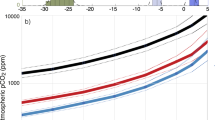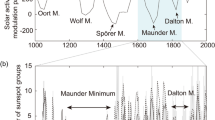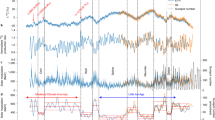Abstract
Plants respond to changes in atmospheric carbon dioxide levels by regulating the number of stomata in their leaves. In his reconstruction of a continuous, 300-million-year record of atmospheric CO2, Retallack bases his curve on stomatal counts of fossil plant cuticles taken from published micrographs1. However, the preservation of cuticles from Permian times is generally too fragmentary for the stomatal index to be reliably determined, the micrographs used could have biased the results, and there are important errors in the supplementary data1 — all of which cast doubt on the Permian part of Retallack's record.
Similar content being viewed by others
Main
Not only do the fragmentary preservation of Permian plant cuticles and the small number of specimens counted call into question the statistical validity of Retallack's stomatal index, but the record may also be biased by reliance on cuticle micrographs that are not representative. In many species, stomata are not evenly distributed — for example, Autunia conferta and Peltaspermum retensorium have very different abaxial (lower) and adaxial (upper) leaf cuticles, particularly with regard to stomata distribution2,3,4,5. The thinner abaxial cuticles have many more stomata, but their cell patterns can be indistinct (the positions of stomata are indicated by papillae on the subsidiary cells).
Most of the micrographs used by Retallack show adaxial cuticles with stomata concentrated between the veins, notably in the central part of the pinnules (leaflets); stomata are rare or absent on the rest of the adaxial side. In P. retensorium, stomata are present only in the basal part of the pinnules5; over 90% of the adaxial surface lacks stomata. The photographs used by Retallack mostly show stomata-bearing pieces of cuticle because stomata are of primary importance for taxonomy; stomata-poor or stomata-free cuticles are rarely shown in such images. Counting only these cuticles may lead to unreliable estimates of stomatal indices. Substantial variations in stomatal index have been reported in extant plants and such data should be interpreted with caution6,7.
Retallack's data1 for the Permian contain several errors: stomatal counts are given for locations that have yielded no cuticle (for example, Sobernheim and Saxony 'Autunia' conferta), and for material not illustrated in this context (Lebach: A. conferta). Ages given for some Permian localities are doubtful (Sobernheim is given as 280 ± 3 Myr (basal part of the Nahe Group (N 4); ref. 8), which is too young: the Grenzlager volcanism that immediately underlies the Nahe Group has been dated (by Rb–Sr dating) at 290.7 ± 0.9 Myr; ref. 9); Frankenberg (253 ± 2 Myr) and Geismar (256 ± 2 Myr) are different designations1 for the same locality, which is of the same age as the British Zechstein localities (Middridge, Kimberly, Cinderhill: 258 ± 2 Myr). Also, Lebach (Sakmarian: 285 ± 3 Myr) and Rümmelbach (Sakmarian–Artinskian: 283 ± 3 Myr) are outcrops in the same horizon (top Lauterecken–Odernheim Formation (L-O 10); ref. 8), underlying the Grenzlager volcanics9, so Retallack's age for Lebach/Rümmelbach is too young). The actual record is thus much more punctuated than proposed1.
Expansion of the atmospheric-CO2 curve into the Palaeozoic era is important, but this should be based on critical evaluation of more reliable data.
References
Retallack, G. J. Nature 411, 287–290 (2001).
Barthel, M. & Haubold, H. Schriftenr. Geol. Wiss. 16, 49–105 (1980).
Kerp, J. H. F. Rev. Palaeobot. Palynol. 54, 249–360 (1988).
Kerp, H. & Barthel, M. Rev. Palaeobot. Palynol. 78, 1–18 (1993).
Naugolnykh, S. V. & Kerp, H. Rev. Palaeobot. Palynol. 91, 35–62 (1996).
Poole, I. et al. Plant Cell Environ. 19, 705–712 (1996).
Poole, I. et al. New Phytol. 145, 511–521 (2000).
Boy, J. A. & Fichter, J. Z. Dt. Geol. Ges. 133, 607–642 (1982).
Lippolt, H. J. & Hess, J. C. N. Jb. Geol. Paläont. Mh. 1989, 553–559 (1989).
Author information
Authors and Affiliations
Corresponding author
Rights and permissions
About this article
Cite this article
Kerp, H. Atmospheric CO2 from fossil plant cuticles. Nature 415, 38 (2002). https://doi.org/10.1038/415038a
Issue Date:
DOI: https://doi.org/10.1038/415038a
Comments
By submitting a comment you agree to abide by our Terms and Community Guidelines. If you find something abusive or that does not comply with our terms or guidelines please flag it as inappropriate.



